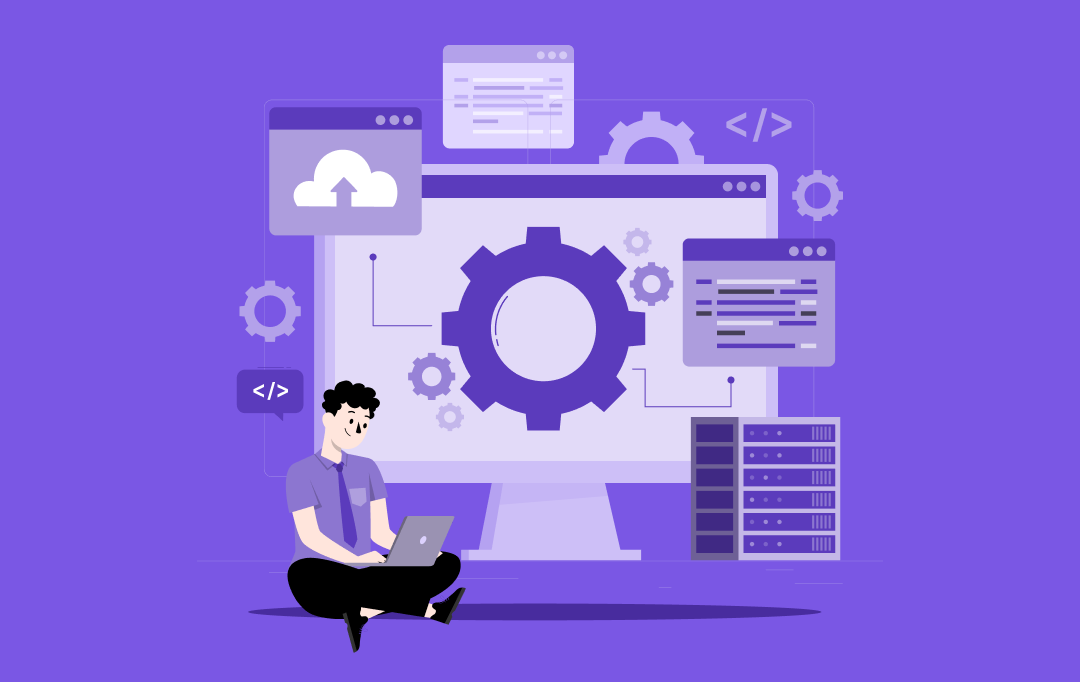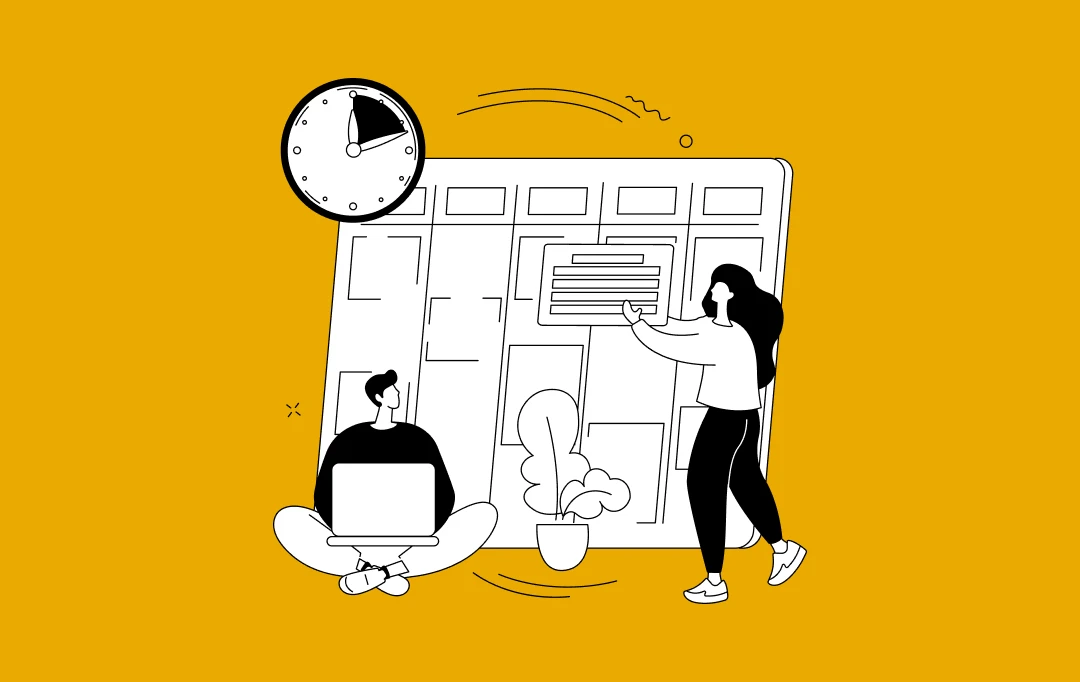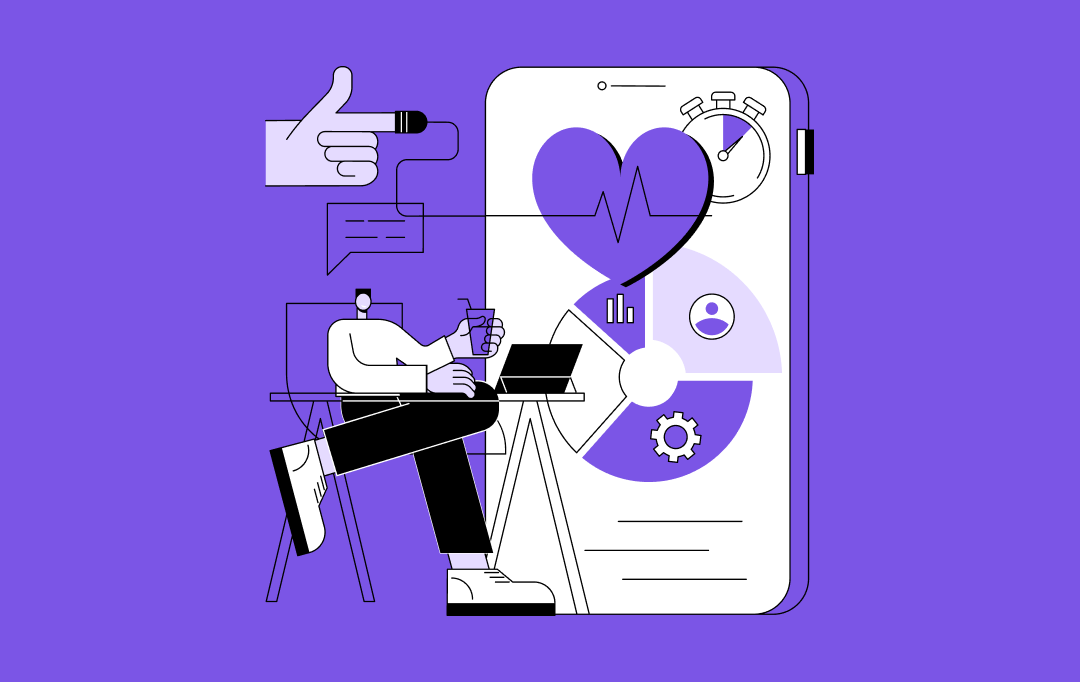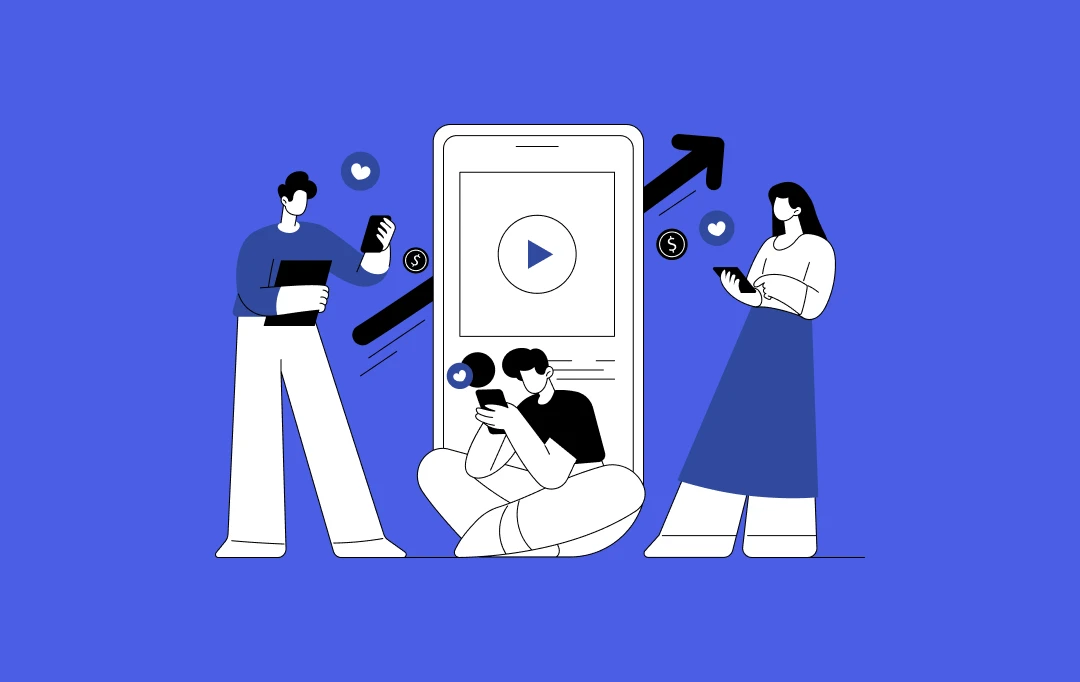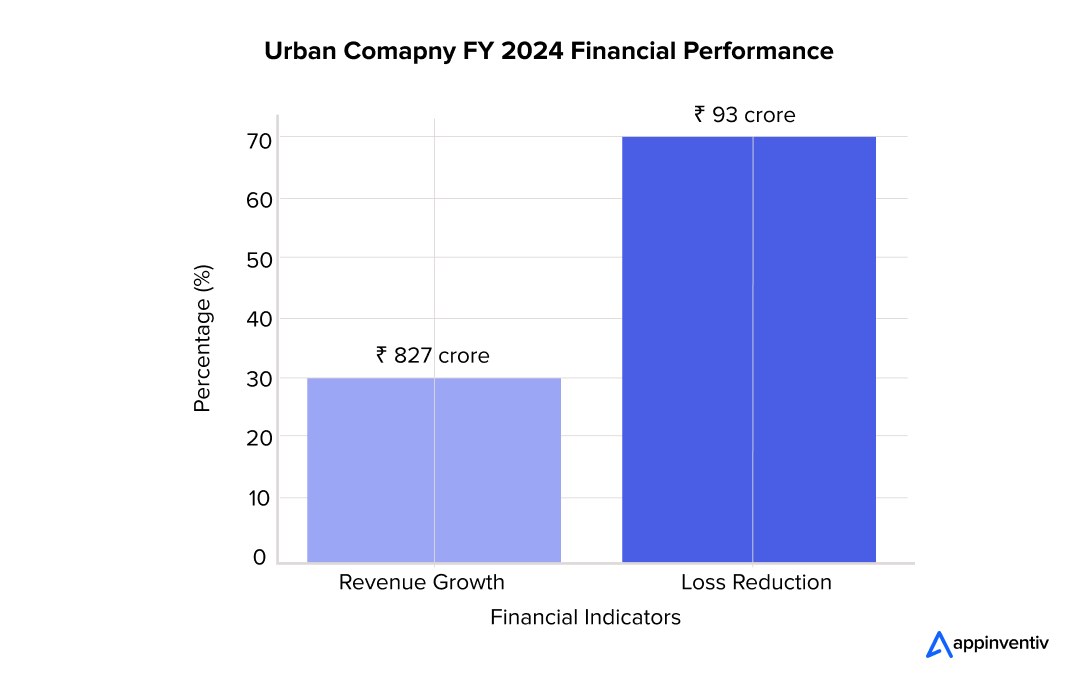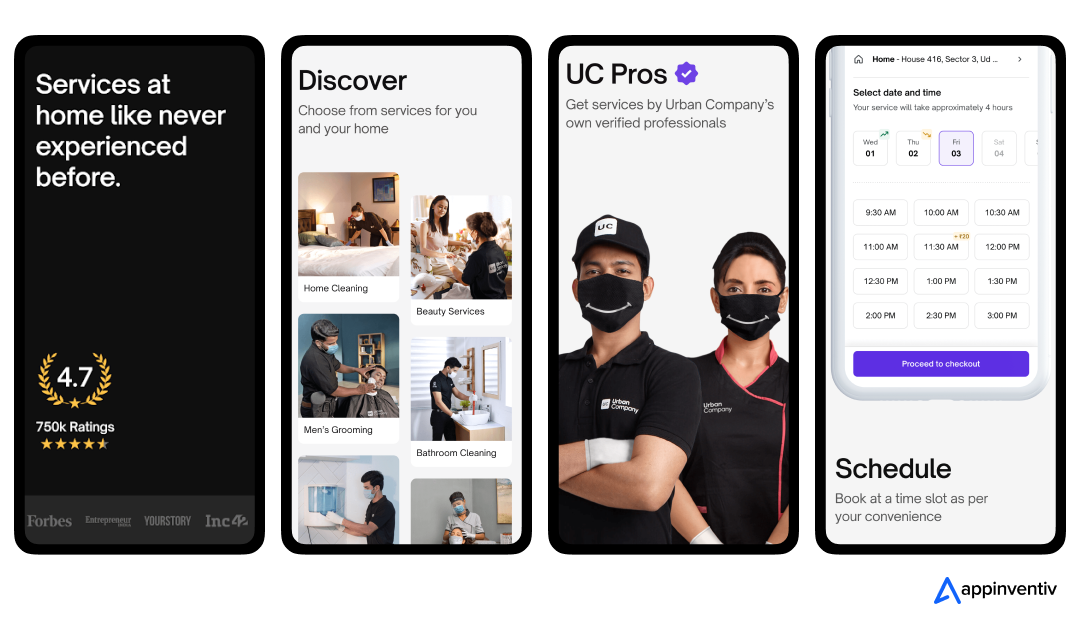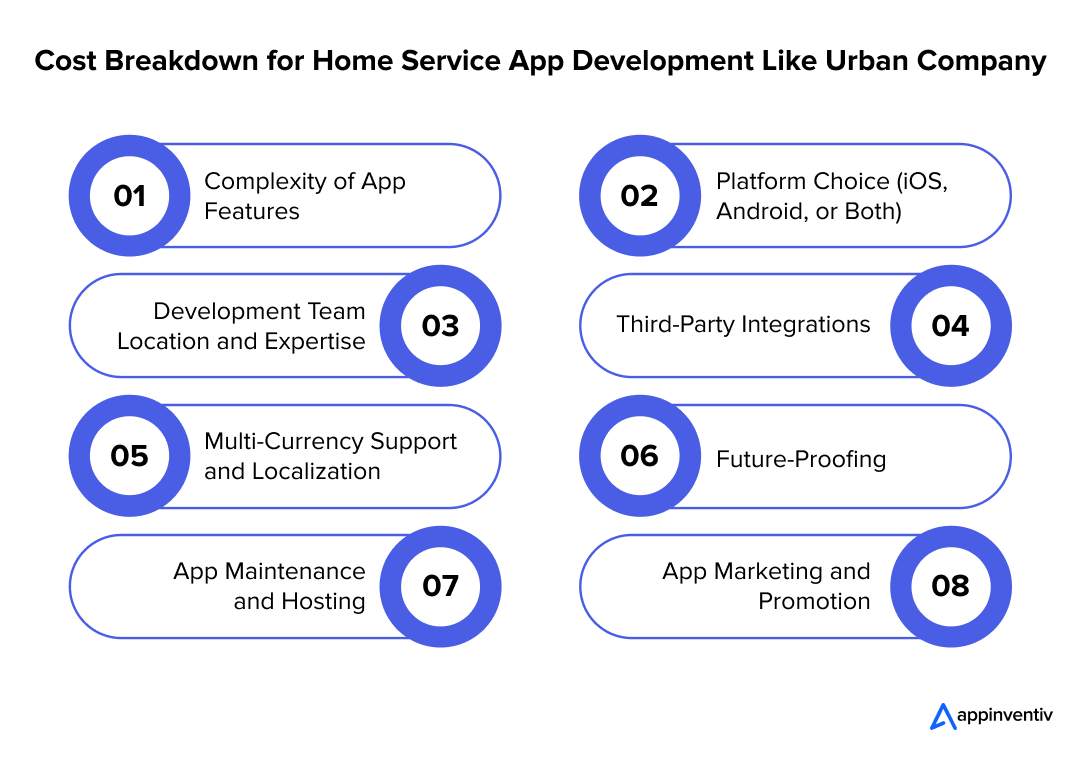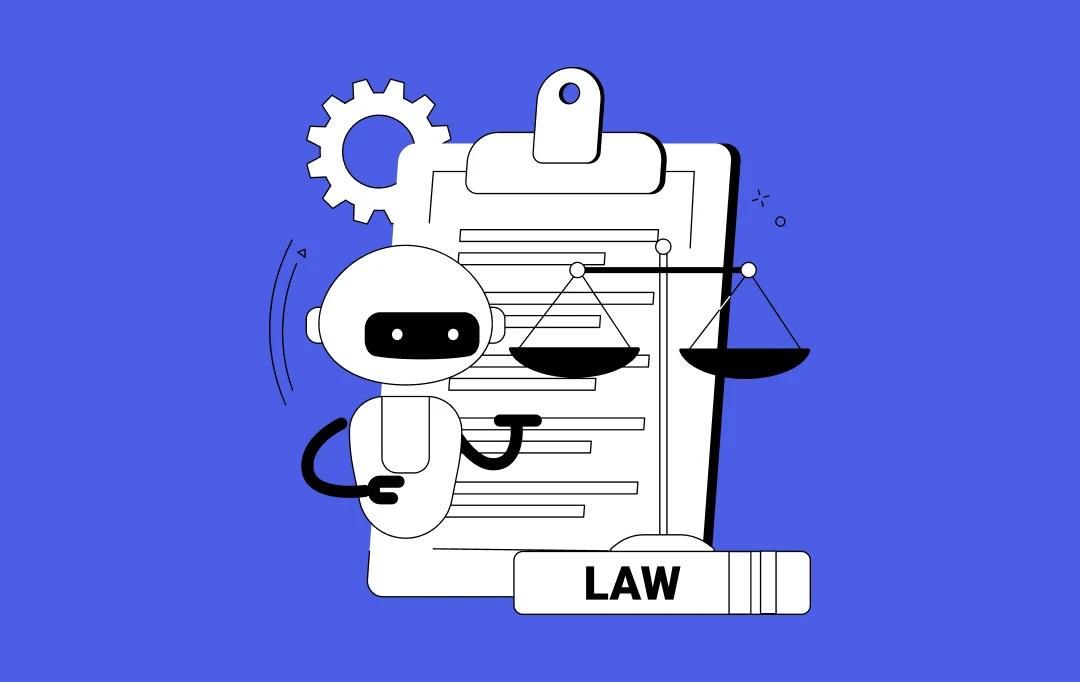The on-demand app industry has revolutionized consumer behavior, making access to essential services easier, faster, and more reliable than ever before. Whether it’s booking a professional cleaner, a plumber, or a beauty expert, apps like Urban Company have set new benchmarks for convenience and efficiency. This shift aligns with changing consumer expectations in a digital-first world, where speed, trust, and personalization are paramount.
Urban Company’s recent performance highlights the increasing dependence on home service apps. In the fiscal year ending March 2024, the company achieved a 30% year-on-year revenue growth, reaching ₹827 crore, while significantly reducing its losses by 70% to ₹93 crore.
The platform also reported a consolidated net revenue growth of 37.3% year-on-year in the first quarter of FY’25. As of April 2024, Urban Company served approximately 5.8 million transacting users, with 77% of its revenue coming from repeat customers, reflecting the trust and loyalty it has cultivated among its user base. (Source: Business Standard)
According to its CEO, Varun Khaitan, Urban Company has also transformed the lives of its service professionals, with those performing over 30 services a month experiencing significant income growth. More than 90% of professionals on the platform have seen a positive shift in their earnings, showcasing the company’s commitment to empowering its workforce. (Source: YouTube)
This robust growth demonstrates the immense potential of home service apps, creating a lucrative opportunity for businesses to tap into this expanding market. But what about the associated costs?
The cost to develop a home service app like Urban Company typically ranges between $40,000 and $300,000 or more, depending on factors like app complexity, advanced features, the technology stack, and the expertise of the development team.
In this blog, we’ll explore the factors influencing Urban Company app clone development costs, key features of such apps, the development process, and effective monetization strategies. Let’s take a closer look to understand how you can build and launch a successful home service app while keeping your budget in check.
Urban Company is a tech-driven platform that makes booking professional home services simple and hassle-free. Whether you need a beauty treatment, a haircut, a massage, deep cleaning, plumbing, carpentry, appliance repair, or even painting, Urban Company connects you with trained professionals who deliver these services right to your doorstep at your preferred time.
The platform is built around the promise of quality, reliability, and convenience. To keep that promise, Urban Company carefully selects its service professionals and supports them with the tools they need to succeed: advanced technology, thorough training, high-quality products, financing options, and even insurance. This ensures they can focus on what they do best: providing top-notch service to customers.
The platform is designed with quality, reliability, and convenience in mind. To support this, it offers an easy-to-use interface, seamless booking, and secure payment options. Service professionals have detailed profiles, complete with ratings and reviews, while customers can track appointments and provide feedback. With real-time updates and dedicated support, the platform ensures that both customers and service professionals can enjoy a smooth, hassle-free experience.
Investing in a home service app like Urban Company has proven to be highly beneficial for stakeholders, offering enhanced customer satisfaction, increased operational efficiency, and access to a large pool of skilled professionals. However, before diving into the development process, it’s important to understand the key factors that influence the cost to develop a home service app like Urban Company.
The cost to develop an app like Urban Company is determined by several factors, with a focus on ensuring an intuitive design, reliable functionality, and scalable performance for a seamless user experience. Let’s check out some of the top factors Urban Company clone app costs.
The complexity of the app and the features you choose to include are the primary drivers of home services platform cost. A basic app with core functionalities like service listings, bookings, and user profiles will cost significantly less than an app loaded with advanced features like real-time tracking, in-app messaging, analytics dashboards, and multiple payment gateways.
Additional features, such as AI-powered service recommendations, multi-language support for global users, and loyalty programs, can elevate user experience but require considerable development time and expertise, further driving up the cost to develop a home service app like Urban Company.
The table below will help you understand the cost breakdown for home service app development according to its complexity levels:
| Category |
Cost Range (USD) |
Details |
| Basic App |
$40,000 – $95,000 |
Includes essential features such as user registration, service provider profiles, basic search and filters, service booking, and a simple admin dashboard for managing users and bookings. |
| Moderately Complex App |
$95,000 – $200,000 |
Adds functionality like advanced search filters, real-time booking and scheduling, secure payment integration, ratings and reviews, service tracking, push notifications, and in-app chat between customers and providers. |
| Enterprise-Level App |
$200,000 – $300,000 |
Offers premium features such as AI-driven personalized service recommendations, loyalty programs, advanced analytics dashboards, dynamic pricing models, multi-language and multi-currency support, and detailed reporting tools for admins. |
Platform Choice (iOS, Android, or Both)
Choosing the platform(s) for your app has a direct impact on Urban Company-like home service app development costs. If you decide to launch the app on a single platform, either iOS or Android, the expenses will be lower than for a cross-platform app.
For those targeting a wider audience, cross-platform frameworks like React Native or Flutter provide a cost-effective alternative to developing separate native apps. However, native app development ensures better performance and tailored experiences, albeit at a higher cost due to maintaining distinct codebases and platform-specific features.
Expertise of the Development Team
The expertise and experience of your development team significantly impact the project budget. A team with a proven track record in on-demand home service app development ensures higher quality and quicker delivery, but this often comes at a higher cost. Hiring a dedicated development team with proven skills in on-demand home service app development ensures higher quality and faster delivery but comes at a premium.
Additionally, the involvement of specialists like UI/UX designers, backend developers, and project managers adds to the overall home service app development cost. It’s also important to factor in ongoing collaboration and communication with the team, which can influence both the timeline and cost of development. Choosing a team with the right balance of experience and expertise will ultimately ensure the best value for your investment.
Third-Party Integrations
Third-party tools like payment gateway integration, map services for location tracking, SMS notification APIs, and analytics platforms simplify app functionality but come with additional costs. Each integration involves setup fees, licensing costs, and development time to ensure compatibility.
For instance, incorporating multiple payment options or integrating tools like Google Maps for navigation requires testing and optimization, which adds to the app’s total cost to develop a home service app like Urban Company.
Multi-Currency Support and Localization
When expanding your app to multiple regions or countries, localization and multi-country support become essential. This process involves translating the app into several languages, adjusting the design to align with cultural norms, and integrating payment systems that accommodate various currencies and local payment methods.
While these enhancements do drive up the Urban Company app clone cost, they are crucial for successfully entering global markets. Providing a localized experience helps ensure that users from different regions can interact with the app in a way that feels familiar and intuitive, boosting user satisfaction and broadening the app’s appeal worldwide.
Future-Proofing
Scalability and future-proofing are essential when developing a home service app like Urban Company. As your user base grows, the app needs to handle higher traffic volumes and the addition of new services without compromising on performance. This necessitates a solid backend infrastructure, cloud storage solutions, and effective database management systems.
Moreover, planning for future updates, service expansions, and potential geographic reach will also impact the initial home service booking app development costs. By focusing on scalability early on, you ensure that the app can evolve with the business, delivering a seamless user experience even as demand increases.
App Maintenance and Hosting
After launch, ongoing maintenance and hosting expenses must be taken into your cost consideration. Regular updates, security patches, bug fixes, and performance optimizations are essential to keeping the app functional and secure. This adds to the overall development costs.
Hosting costs depend on factors like server type (shared, dedicated, or cloud-based), bandwidth usage, and storage requirements. Typically, annual maintenance costs range around 20% of the initial development cost, making it a significant long-term investment.
App Marketing and Promotion
Effective marketing and promotion are essential for user acquisition and retention, adding to overall development costs. Strategies like App Store Optimization (ASO), paid ads, influencer collaborations, and content marketing require ongoing investment. Paid promotions and influencer partnerships can be expensive but are crucial for visibility.
Without proper marketing, even a well-built app may struggle to gain traction, making it a necessary yet costly aspect of app development.
Top Features of On-Demand Apps Like Urban Company
On-demand apps like Urban Company are built with three distinct panels: one for customers to book and manage services, another for service professionals to receive and fulfill requests, and an admin panel to oversee operations, ensuring seamless user functionality. Let’s have a closer look at those, beginning with the admin panel.
Admin Panel
The admin panel is the backbone of the app, providing the tools necessary for managing the platform. Here are some of the top home service app features of the admin panel.
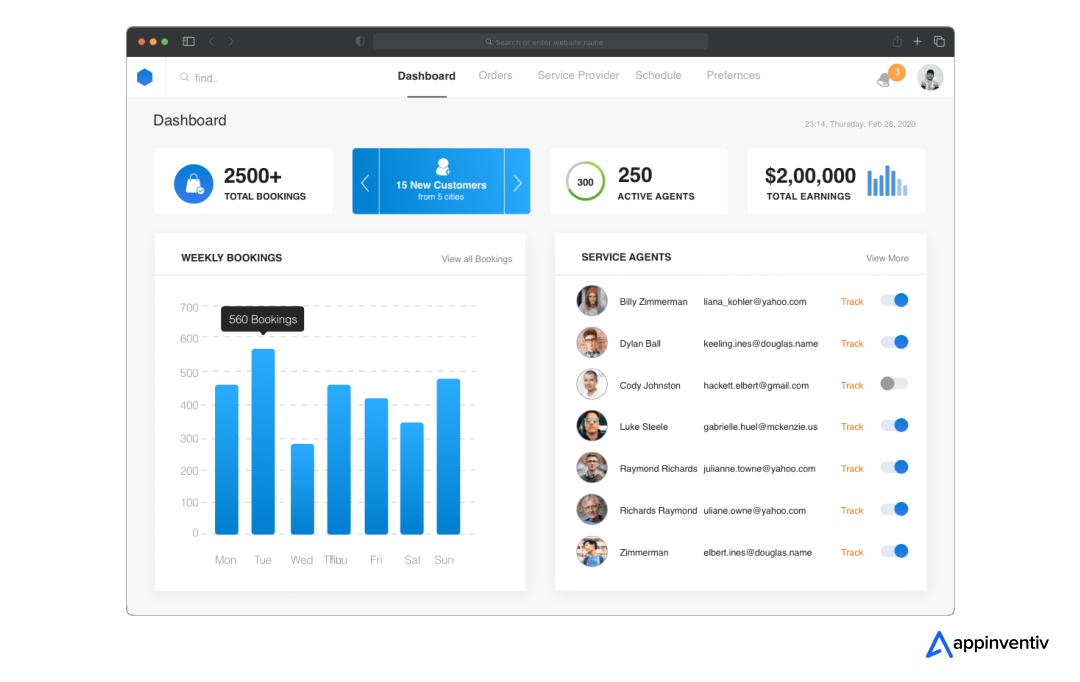
- Booking Management: Oversee and manage all bookings, cancellations, and refunds.
- Vendor Monitoring: Track vendor performance through ratings, reviews, and job completion rates.
- Commission Setup: Define and manage commission structures for service providers.
- User and Vendor Management: Approve service providers and monitor user activities.
- Promotions and Discounts: Create and launch promo codes, offers, and loyalty programs.
- Customer Support Tools: Resolve disputes and handle complaints via live chat or ticket systems.
- Performance Analytics: Generate detailed reports on revenue, bookings, and platform usage.
- Payment Handling: Manage vendor payouts and monitor financial transactions.
- Service Customization: Add, update, or remove service categories as needed.
- Content Updates: Control app content like FAQs, terms, and notifications.
Partner/Service Provider Panel
This panel empowers service providers to manage their profiles, bookings, and earnings effectively while enabling smooth communication with customers for a hassle-free experience. Let’s have a look at its features.
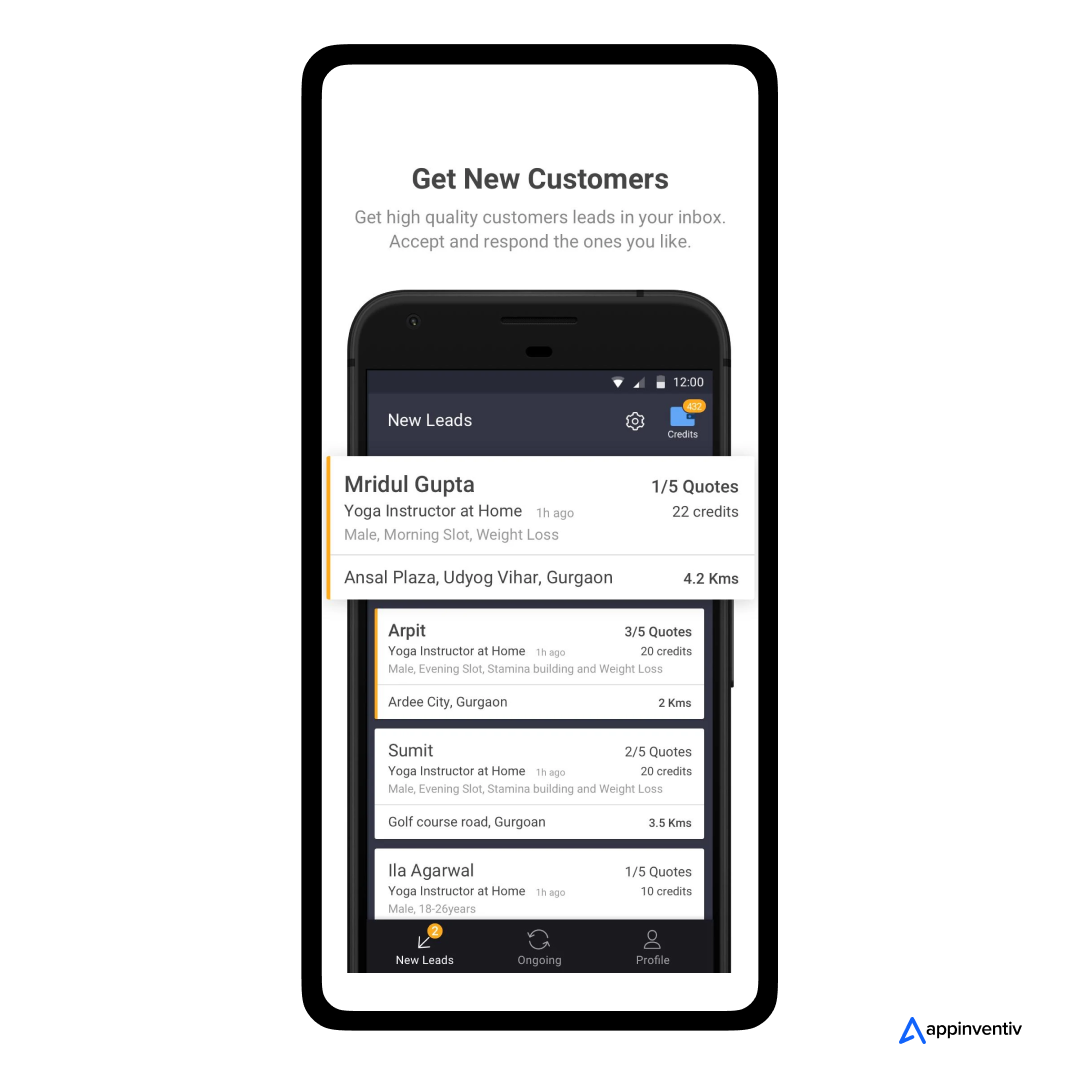
- Profile Management: Set up and update service details, photos, and availability.
- Job Notifications: Receive and accept/reject booking requests instantly.
- Service History: Track completed, ongoing, and canceled bookings in one place.
- Earnings Dashboard: Monitor earnings with detailed breakdowns of commissions and payouts.
- In-App Communication: Chat or call customers for instructions or updates.
- Availability Settings: Set working hours or mark time as unavailable.
- Ratings and Feedback: View customer reviews and respond to feedback.
- Navigation Support: Access maps for real-time directions and route optimization.
- Work Schedule Management: Manage appointments and reschedule bookings if needed.
- Verification Uploads: Submit documents for background checks and approvals.
Customer Panel
This panel offers customers an intuitive platform to discover services, book appointments, track updates, and handle payments seamlessly, ensuring a smooth and convenient user experience. Let’s have a look at the key features.
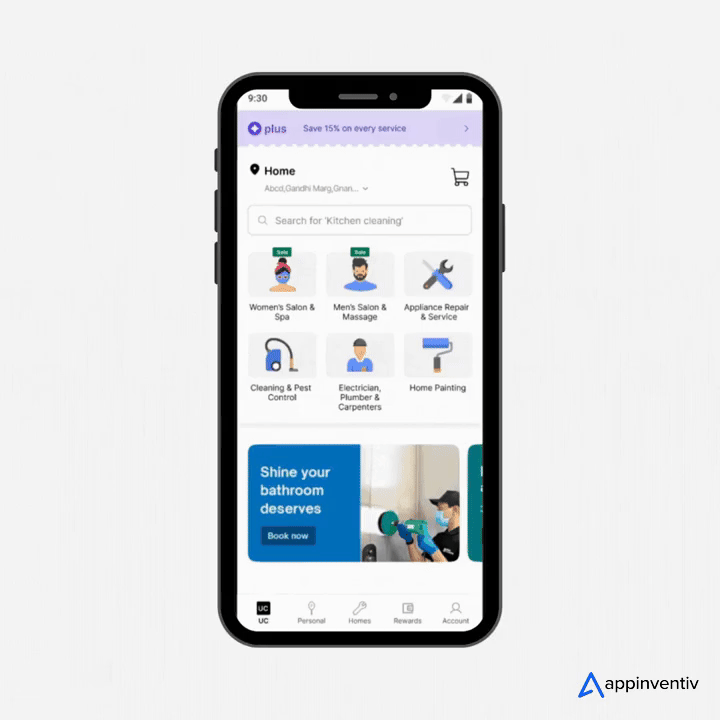
- Service Browsing: Search and filter a wide range of services by category, price, and ratings.
- Easy Registration: Sign up quickly using email, phone, or social media accounts.
- Real-Time Tracking: Monitor the service provider’s location and estimated time of arrival.
- Flexible Bookings: Book services instantly or schedule them for a preferred time slot.
- Payment Options: Pay securely via multiple methods like cards, wallets, UPI, or cash.
- Push Notifications: Receive updates about bookings, promotions, and exclusive offers.
- Customer Support: Access in-app support for resolving issues or answering queries.
- Offers and Discounts: Redeem promo codes, referral rewards, or subscription benefits.
- Ratings and Reviews: Provide feedback and view other users’ reviews for informed decisions.
- In-App Communication: Contact the service provider directly through chat or calls.
Ways to Optimize Urban Company-Like App Development Costs
Optimizing app development costs is essential for ensuring that the project stays within budget while still delivering a high-quality product like Urban Company. Let’s check out some of the top ways to optimize the app development costs of home service app functionalities.
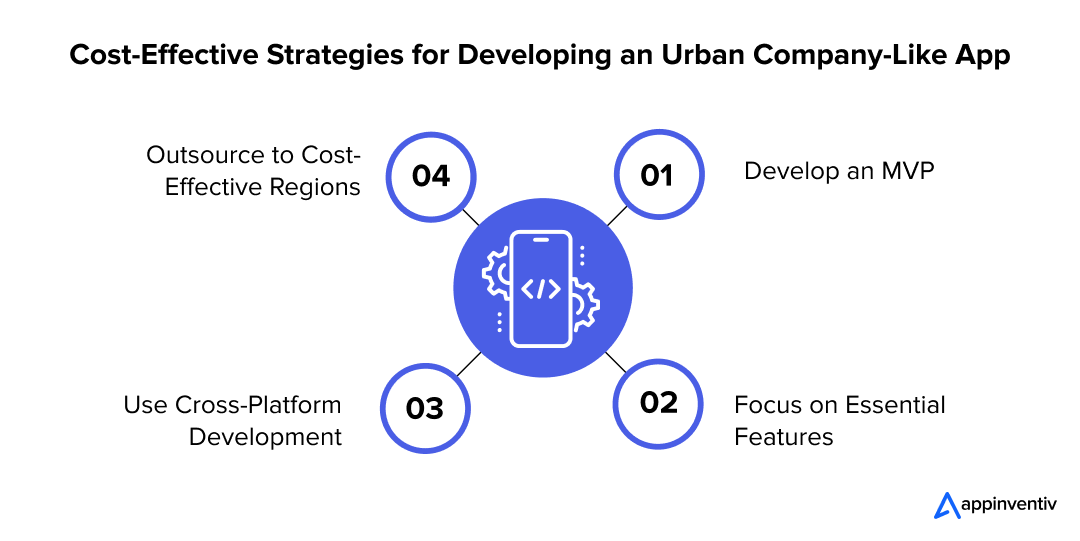
Develop an MVP (Minimum Viable Product): Start with a basic version or MVP of the app that includes only essential features, which helps reduce initial costs while allowing you to gather user feedback and validate the concept.
Focus on Essential Features: Prioritizing key functionalities such as booking, payment, and service tracking ensures the app addresses core needs while avoiding unnecessary features that could inflate costs.
Use Cross-Platform Development: Building the app for both iOS and Android using a single codebase reduces the need for separate development efforts, saving both time and money.
Outsource to Cost-Effective Regions: Outsourcing your app development project to regions where labor costs are lower enables you to access expertise without compromising the quality of the app, helping to optimize the overall budget.
Key Steps to Build an App Like Urban Clap
Building an app like Urban Clap requires a strategic approach to create a seamless user experience, ensuring functionality, reliability, and scalability to meet the needs of both customers and service professionals. Let’s have a look at the key steps involved in home service mobile app development.
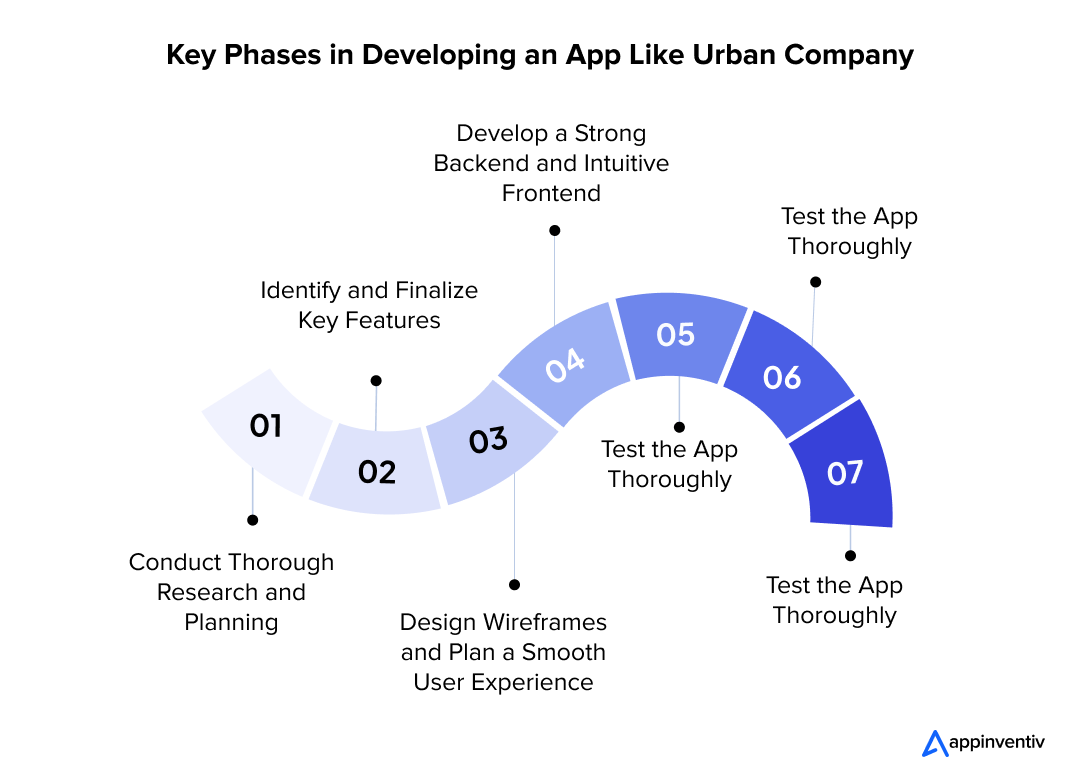
Conduct Thorough Research and Planning
Start by diving deep into market research to understand the needs of your target audience. This is the first step of the home service app development process. Identify the gaps in current services, what your competitors are offering, the common pain points in existing apps, and figure out how your app can solve them better.
Define your unique selling proposition (USP) and finalize a business model, whether it’s commission-based, subscription-driven, or a hybrid. This step is crucial for ensuring your app aligns with real user demands while offering a unique edge in the competitive home services market.
Identify and Finalize Key Features
Carefully plan the features for each user type: customers, service providers, and admins. For customers, think about options like browsing services, booking appointments, making payments, and tracking providers in real-time. Service providers need tools to manage their schedules, track earnings, update availability, and communicate with customers.
Admins should have a powerful dashboard to oversee all activities, analyze performance metrics, and manage disputes. Well-defined features tailored to each group will ensure your app serves all stakeholders effectively.
Design Wireframes and Plan a Smooth User Experience
Before diving into development, create wireframes to map out how your app will look and function. Prioritize an intuitive, visually appealing interface that works seamlessly on all devices. Think about reducing unnecessary steps and making navigation straightforward.
Whether it’s booking a service or tracking earnings, every user interaction should feel simple and effortless. Investing in a thoughtful design at this stage will make a lasting impression on users and encourage them to keep using your app.
Develop a Strong Backend and Intuitive Frontend
Focus on building a secure, scalable backend using technologies like Python, Node.js, or Ruby on Rails to handle critical tasks like bookings, notifications, and payments. At the same time, develop a user-friendly frontend using modern frameworks like Flutter or React Native for a smooth and consistent experience across iOS and Android.
APIs should seamlessly connect the backend and frontend to ensure everything runs smoothly. This is the technical backbone of your app and needs to be robust for long-term success.
Test the App Thoroughly
Before launching, test your app rigorously to ensure it performs flawlessly. Functional testing will confirm that every feature works as intended, while usability testing ensures the interface is easy to navigate.
Test its performance under heavy traffic to avoid slowdowns or crashes. Conduct beta testing with real users to gather feedback and spot areas for improvement. This step is critical for delivering a polished product that users can rely on.
Launch Your App Strategically
Once you’re confident in your app’s performance, release it on Google Play or Apple App Store. Generate interest with a launch campaign that includes targeted online ads, social media promotions, and maybe even a referral program to encourage early adoption.
Offer incentives like discounts or limited-time offers to attract users and service providers to sign up. A strong launch sets the tone for your app’s growth and helps establish your brand in the market.
Also Read: Customer Loyalty App Development – Benefits, Process, Costs
Gather Feedback and Continuously Improve
After your app is live, don’t stop engaging with users. Collect feedback through app reviews, surveys, and support channels to understand what’s working and what needs fixing. Pay attention to analytics to track user behavior and identify trends.
Use this information to roll out regular updates with new features, improved functionality, and bug fixes. Continuously improving your app ensures it stays relevant and keeps users satisfied. However, it is also important to note that app maintenance leads to an increased cost to develop a home service app like Urban Company.
Ways to Make Your App Outshine Urban Company
To make your app outshine Urban Company, it’s crucial to prioritize innovation, user-centric features, and exceptional performance. By implementing these strategies, you can differentiate your app from others and keep users engaged. Here’s a list of ways to help you achieve this and take your app to the next level.
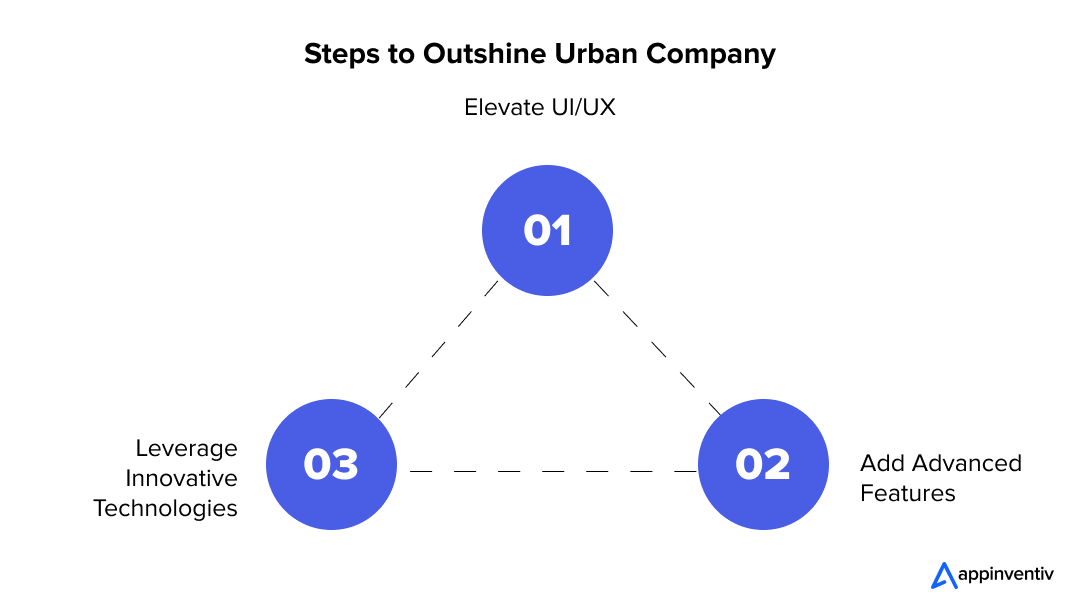
Elevate UI/UX
When building an app like Urban Company, your focus should be on creating an intuitive and user-friendly interface. Prioritize fast load times, smooth navigation, and visually appealing design elements. Personalizing the layout based on user preferences and behaviors will help ensure a seamless experience, keeping your users engaged and satisfied.
Add Advanced Features
Consider integrating features that boost user convenience to make your app better than Urban Company. AI-powered service recommendations can help suggest relevant services based on user preferences, while real-time tracking with accurate ETAs ensures transparency. Incorporating more such advanced features will enhance overall user satisfaction and provide a competitive edge to your business.
Leverage Innovative Technologies
Utilize advanced technologies like AI, machine learning, and AR to outshine Urban Company. For instance, AI can predict user needs and provide personalized suggestions, while AR can help users visualize services, like home repairs, in real-time. By ensuring seamless integration across various devices and platforms, you’ll enhance the app’s performance and reliability, providing a smooth user experience.
Monetization Strategies for an On-Demand App Like Urban Company
Monetization for an on-demand app like Urban Company is centered on ensuring long-term profitability while delivering continuous value to both customers and service professionals. This approach helps the platform remain competitive and sustain growth over time. Let’s check out the key revenue drivers for home service app development like Urban Company.
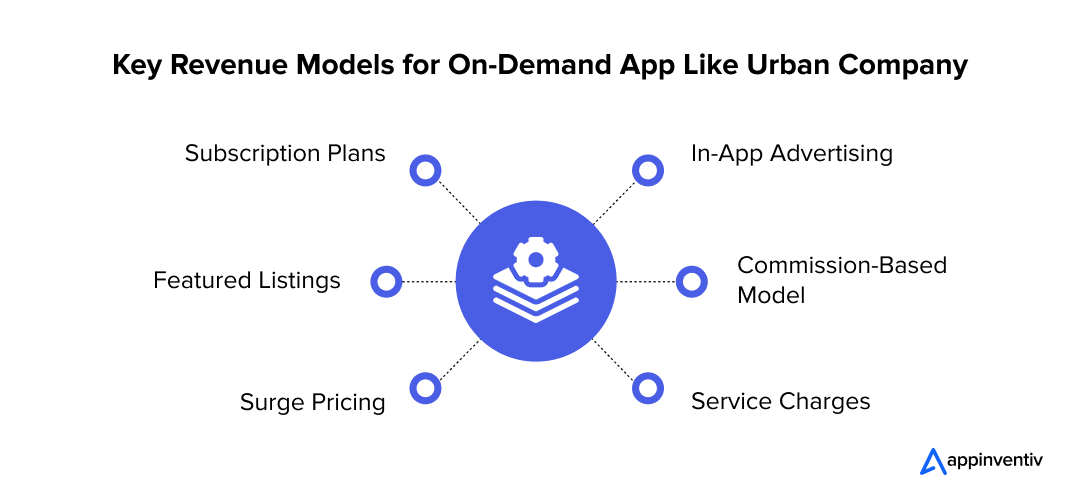
In-App Advertising
Allow service providers or third-party businesses to advertise on the platform for a fee. This could include banner ads, sponsored listings, or promotional campaigns targeted at specific user segments.
For example, cleaning product manufacturers or home appliance companies might find this an attractive advertising space. In-app ads can be a significant revenue source if implemented without disrupting the user experience.
Commission-Based Model
Charge service providers a percentage of each transaction made through the platform. This model ensures a steady revenue stream as the app grows and gains users. For instance, the platform can take a 10-20% commission for every successful booking. This model incentivizes quality service since providers benefit directly from high customer satisfaction, which leads to repeat bookings and higher earnings.
Service Charges
Introduce a convenience fee for customers on every transaction, such as booking or cancellation fees. These charges can be a fixed amount or a percentage of the total bill. Service charges ensure a small yet consistent revenue from every customer interaction. It also allows the app to cover operational costs while maintaining a seamless user experience.
Surge Pricing
Implement dynamic pricing during peak demand times, such as weekends or holidays. Service charges could be increased during high-traffic periods, similar to ride-hailing apps. This maximizes revenue during busy times and adequately compensates service providers for handling increased workloads.
Featured Listings
Provide service providers with an option to pay for higher visibility in search results or a spot in the “Featured” section. This strategy encourages providers to invest in gaining more exposure, especially in highly competitive categories. It generates additional revenue and promotes healthy competition among service providers to improve their offerings.
Subscription Plans
Offer subscription packages to both service providers and customers. Service providers can pay for premium features like better visibility, advanced analytics, or priority listing in search results. Similarly, customers can subscribe to plans that offer perks such as discounts, free cancellation, or exclusive offers. Subscription plans generate recurring income and improve user loyalty by offering added value.
Also Read: How Much Money Can You Earn Through An App?
Launch a Seamless Home Service App Inspired by Urban Company with Appinventiv
The home service app market is experiencing explosive growth as consumers increasingly prioritize convenience, efficiency, and accessibility. With busy lifestyles and the demand for quick solutions, apps offering on-demand services like home cleaning, repairs, beauty, and fitness have become essential.
This trend is not just a passing phase—technological advancements like AI-driven personalization, real-time tracking, and seamless digital payments are setting the stage for the future of home service apps, creating opportunities for businesses to tap into this thriving market.
If you’re looking to build a home service app that stands out, Appinventiv is your perfect partner for on demand app development company. With years of expertise in app development and a client portfolio featuring global brands like KFC, Dominos, IKEA, Adidas and on-demand apps like ActiDrive, Appinventiv delivers tailored, scalable, and innovative solutions.
As a reputed mobile app development service provider, we have maintained a strong reputation within our global clientele cycle which is reflected in our testimonials. Our client testimonials show how we transformed ideas into market-ready products.
Take the first step toward creating your own app by consulting Appinventiv’s experts and get a detailed estimation of Urban Clap like app development costs.
Reach out today, and let us help you bring your vision to life!
FAQs
Q. How to build a home service app like Urban Company?
A. Here are some of the vital steps to build an app like Urban Clap:
- Perform Market Research: Understand your audience, analyze competitors, and identify service gaps.
- Define Your Revenue Model: Decide on earnings through commissions, subscriptions, or service fees.
- Design an Intuitive Interface: Create a responsive, accessible, and visually appealing UI/UX.
- Start with an MVP: Build a Minimum Viable Product to validate features and gather early feedback.
- Conduct Extensive Testing: Test for bugs, performance, and cross-platform compatibility.
- Launch and Market Smartly: Promote your app with targeted campaigns to attract users effectively.
Q. How long does it take to develop a real estate app like Urban Company?
A. Home service mobile app development like Urban Company typically takes 4-9 months, depending on the features, complexity, and whether you’re targeting iOS, Android, or both platforms. A basic app with essential features can be developed faster, but adding advanced functionalities like real-time tracking, AI-based suggestions, or multi-language options may take longer.
Q. How much does it cost to build a home service app like Urban Company?
A. The cost to develop a home service app like Urban Company generally ranges from $40,000 to $300,000 or more. This variation depends on factors such as the app’s complexity, the range of features, the chosen technology stack, and the design requirements.
Apps with advanced functionalities and custom integrations typically require a higher budget, as do projects involving highly experienced development teams or targeting multiple platforms.
Product Development & Engineering
IT Managed & Outsourcing
Consulting Services
Data Services
Didn't find what you're looking for? Let us know your needs, and we'll tailor a solution just for you.




